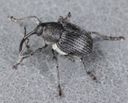Curculionini
Curculionini
Classification
- Phylum: Arthropoda
- Subphylum: Hexapoda
- Class: Insecta
- Order: Coleoptera
- Suborder: Polyphaga
- Superfamily: Curculionoidea
- Family: Curculionidae
- Subfamily: Curculioninae
- Tribe: Curculionini
Pronunciation
How to pronounce Curculionini: //kɜrˌkjʊliˈoʊnɪnaɪ//
These audio files are automatically generated. While they are not always 100% accurate, they are a good starting point.
Images






Summary
Curculio nucum, the nut weevil, is a significant pest in hazelnut orchards, characterized by its elongated snout and medium size. It has a two-year life cycle, feeding within hazel nuts and laying eggs inside them, thus impacting hazelnut crops.
Physical Characteristics
Medium-sized beetle ranging from 6 to 8.5 mm. The female's snout is as long as the rest of the body, reddish at the end. Males have snouts about 1/3 shorter. Body cover is usually light brown, resembling mature hazelnuts.
Identification Tips
Curculio nucum is often confused with Curculio glandium, which lives on oaks. They can be distinguished by differences in the morphology of the flagellum – C. nucum has broader flagellum segments covered with semi-erect hairs, while C. glandium has adpressed hairs.
Habitat
Found in hazelnut orchards, particularly within the tissues of hazel nuts (Corylus avellana).
Distribution
Occurs in most of Europe, from southern Sweden, Finland, and Great Britain to the Mediterranean.
Diet
Adults feed on hazel buds and leaves. Larvae develop inside hazelnuts, consuming most of the nut's content.
Life Cycle
Life cycle typically lasts two years. Adults emerge in spring, feed until August, and lay eggs in hazelnuts. Larvae feed inside the nuts, exit to burrow into the soil, where they overwinter and undergo metamorphosis.
Reproduction
Females oviposit a single yolk-rich egg in each maturing hazelnut, laying up to 20-30 eggs overall.
Ecosystem Role
Considered a serious pest in hazelnut orchards.
Economic Impact
Curculio nucum is a pest that could affect the yield of hazelnuts, impacting agronomy in nut-producing regions.
Evolution
Part of the glandium clade alongside closely related species like Curculio glandium and C. undulatus.
Similar Taxa
Misconceptions
Often confused with another weevil species, Curculio glandium, though they have distinct morphological differences.
Tags
- Curculio nucum
- nut weevil
- Curculionini
- pest
- hazelnuts